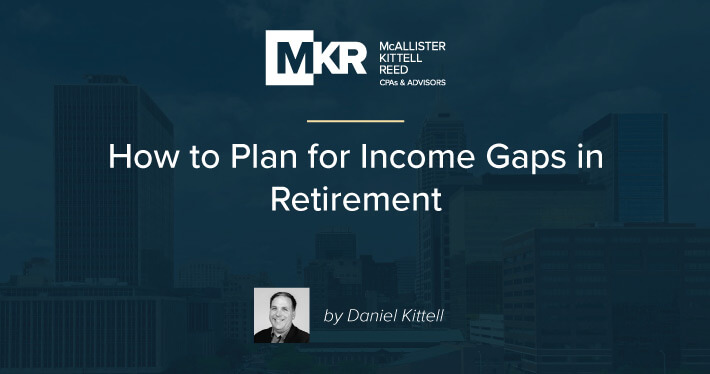
by Jean Miller | Accounting News, Financial goals, News, Retirement, Retirement Savings, Uncategorized
Individual Retirement Accounts (IRAs) allow for a tax-advantaged way to invest your money long-term. Whether you choose to invest in a traditional IRA or a Roth IRA (or a combination of the two), you’ll defer paying income tax on the money you set aside for retirement. Follow these IRA investment strategies to boost your retirement savings and maximize the value of you IRA.
Max it Out
The maximum amount you can contribute to an IRA for 2022 is $6,000, and it is generally worth making the maximum contribution. Note that there are income limits. You can make a full contribution if your income is less than $144,000 ($214,000 if you are married filing jointly). For 2022, retirement savers age 49 and younger can max out an IRA by saving $500 per month or making a deposit any time before the 2022 IRA contribution deadline of April 15, 2023.
Make Catch-Up Contributions
As of the calendar year you turn age 50, you are eligible to contribute an extra $1,000 to your IRAs for that year, and all following years. If you weren’t able to save as much as you would’ve liked earlier in your career, catch-up contributions offer an opportunity to boost your yearly savings until retirement.
Don’t Wait Until the Contribution Deadline
It’s true that you can make a contribution to an IRA up until the mid-April tax filing deadline and apply it to the previous tax year. By shifting some funds into an IRA, you may be able to reduce your tax bill or boost your refund. However, that may not be the most beneficial move depending on your circumstances. When you wait to contribute, you miss out on potential growth. There is also the chance that you will be making an investment at a high point in the market. Contributing to an IRA at the beginning of the tax year enables the funds to compound for a longer stretch of time. You can also consider making small monthly contributions as a budget-friendly approach that will still yield favorable results.
Low- and Moderate-Income Workers Can Claim the Savers Credit
If your adjusted gross income (AGI) is below $34,000 as an individual or $68,000 as a couple in 2022, you may be eligible to claim the saver’s tax credit as well as the tax deduction for your IRA contribution. This credit is worth between 10% and 50% of the amount you contribute to an IRA up to $2,000 for individuals and $4,000 for couples.
Use Your Tax Refund to Contribute to Your IRA
You can use IRS Form 8888 to deposit all or part of your tax refund directly into an IRA. Provided the deposit is made by the due date of your tax return, you can file a tax return claiming a traditional IRA contribution before the money has actually been deposited in the account. In other words, if you file earlier rather than later, it’s possible to use your tax refund to make an IRA contribution you already claimed on your tax return.
Consider Converting to a Roth IRA
For some taxpayers, it may be beneficial to convert an existing traditional IRA to a Roth IRA. Expect to pay income taxes on the conversion amount, which could be substantial, so be sure to do the math before you make the leap. The funds that are moved into the Roth grow tax-free and will be tax-free upon withdrawal in the future, provided the account is at least five years old. The decision to convert to a Roth IRA basically boils down to whether you want to take the tax hit now or later. The farther away you are from retirement, the more advantageous a Roth IRA could be, because the Roth’s earnings will have more years to compound.

by Jean Miller | Accounting News, News, Retirement, Retirement Savings
Although retirement planning often involves some guesswork regarding the future of the economy as well as each retiree’s individual circumstances, there are some general misconceptions to avoid in order to be sure you’re building a solid nest egg. We go through these common beliefs below so you are informed when setting goals for retirement.
The 4% Rule is Steadfast
The 4% rule has been regarded as a sound retirement distribution strategy for years. With this method, retirees withdraw 4% from their retirement portfolio during the first year of retirement. The amount then increases each year according to inflation. This method, in theory, should yield a consistent stream of income for at least a 30-year retirement. However, given market expectations—namely, lower projected returns for stocks and bonds—the general consensus is that the 4% rule be amended to 3.3%. This may seem like a small difference, but it could have a big impact on your standard of living. The difference would be even more evident later in retirement, when accounting for inflation.
You Can Live Off Social Security Benefits
Social Security will only replace about 40% of preretirement income. Given that retirees need to replace approximately 80% of preretirement earnings to prevent a significant reduction in quality of life, Social Security Benefits will fall way short of this mark. Make sure your game plan includes additional savings from investment accounts to cover the discrepancy.
You Can Start Withdrawing Social Security at 65 Years Old
When the Social Security Act was signed into law in 1935, it established age 65 as the full standard benefit age. Couple this with the fact that 65 is also the Medicare eligibility age, and Americans have long considered 65 to be the standard retirement age. However, while Medicare eligibility age remains the same, full retirement age (FRA) has since changed. Depending on a retiree’s birth year, their FRA can be anywhere from age 66 and four months to age 67. This means that if you start Social Security at 65 (before your FRA), you will be subject to early filing penalties that could slash a substantial portion of your monthly check. Be sure to check your online Social Security account to be informed of your FRA and the appropriate timeline for claiming benefits.
Saving 10% of Income for Retirement is an Adequate Goal
For decades, workers followed the rule of thumb to save 10% of their salary for retirement. However, longer life spans, lower projected market returns, and the declining value in Social Security benefits have all contributed to the need to save more. It’s important to work with a financial advisor to come up with a personalized plan for retirement goals, but at the very minimum, aim to save 15% to 20% of income.
Medicare Will Provide Sufficient Coverage for Care
Medicare often doesn’t provide enough coverage for seniors ages 65 and older. Factors such as high insurance costs and coverage exclusions contribute to the need for supplemental coverage, such as Medigap. And sometimes seniors find that a Medicare Advantage policy—the private insurance alternative to traditional Medicare—is a better fit. No matter what you ultimately decide, it’s crucial to devote specific funds to medical costs, either in a health savings account or another tax-advantaged retirement account.

by Daniel Kittell | Accounting News, News, Retirement, Retirement Savings, Social Security
While Social Security typically plays a role in planning for retirement, it’s important to be clear on the specifics of this benefits program. It definitely can be a source of financial support, but there are a few realities to be aware of so you’re not caught off guard when the time comes to make use of these benefits.
Social Security Benefits Fall Far Short of Replacing Income
In fact, Social Security replaces only about 40% of pre-retirement income. When you retire it’s generally advised to have enough money coming in to replace at least 80% of pre-retirement income in order to avoid a major drop in quality of life. Income from sources such as a pension or savings will be needed to fill the gap.
Your Benefits Could Be Taxed
Approximately 50% of retirees pay some federal taxes on their Social Security benefits. This is because their combined income from Social Security and other sources bumps them above the thresholds for taxes to kick in. These thresholds—$25,000 for single people and $32,000 for married joint filers—aren’t indexed to inflation. Due to natural wage increase, more and more people are going to end up with provisional incomes above the stated thresholds, so the percentage of Americans who are required to pay some taxes on Social Security benefits is expected to increase over time.
Medicare Premiums Are Deducted from Your Social Security
If you receive Social Security benefits and you are enrolled in Medicare Part B (the portion of Medicare that provides standard health insurance), the premiums for Medicare are typically automatically deducted from Social Security payments.
Claiming Benefits Early Could Result in Smaller Monthly Checks
If you opt to begin receiving Social Security before your full retirement age, you will not get your standard benefit amount. Full retirement age differs by birth year, but it ranges between 66 and 2 months and 67 years old. Depending on how far you are from your full retirement age when you start claiming benefits, you could fall short of your benefit rate by as much as 30%.

by Pete McAllister | Accounting News, News, Retirement Savings
No matter the reason for leaving a company, you need to decide what to do with your employer-sponsored retirement plan within 60 days of leaving. If you miss this deadline, you risk the plan being automatically distributed to you or moved to another retirement account. You have several options for your 401(k) plan, and we’ll go over them below.
Keep the Money Where It Is
First, your company should be clear about whether you can keep the funds where they currently are—in your former employer’s plan. Some employers approve this if you have at least a $5,000 balance. You might choose this option simply because you are familiar with the investment options, or because the fees are lower than your new employer’s plan.
Choose a Plan-to-Plan Rollover Option
Many employers offer a plan-to-plan rollover into their 401(k) or other qualified retirement plans. This move doesn’t acquire any tax consequences or penalties. As long as you like the investment options in the new plan, this rollover option can be an obvious choice to keep your savings momentum.
Keep in mind that if you move the money as a withdrawal from the old plan and deposit it to a new plan, rather than choosing the rollover option, your employer may withhold 20% of the sum for taxes. It is your responsibility to report this amount on your taxes for the year the distribution was made.
Roll the Money Over Into an IRA
A direct rollover into an IRA does not incur tax consequences or penalties, and there is an abundance of investment options to choose from—including stocks, bonds, mutual funds, and ETFs. If you typically move jobs intermittently, moving the money into a rollover IRA might be a good option. This way all of your 401(k)s and retirement plans can have one home.
One drawback to this option is that you will no longer be making automatic contributions, so that might curb your savings drive. However, rollover IRAs are commonly flexible, so moving your assets into a future employer’s plan might be an option.
Use the Money
Using the money for personal expenses is an option by taking a lump-sum distribution, but it will cost you. You will owe income taxes on it, and for workers under age 59 ½, you will likely pay a further 10% penalty. Depending on your tax bracket and state and local taxes, you could lose a significant amount of your retirement stash.
Employer Distribution
If your 401(k) balance is less than $1,000, your employer could release the funds via a lump-sum distribution, whether or not you requested it. If this happens and you are within 60 days of terminating your old plan, immediately roll the money into a new employer’s plan or a rollover IRA.
If your balance is more than $1,000 but less than $5,000, your plan administrator is required to move the funds into an IRA unless you specifically request another type of distribution.
In general, according to the Internal Revenue Service (IRS), if your savings is less than $5,000, your employer is permitted to distribute the funds from the plan without your authorization. You should be able to claim on your tax return any taxes or penalties your previous employer triggered when the distribution was made, but it might help to discuss this situation with a tax professional before you file.

by Daniel Kittell | Accounting News, News, Retirement, Retirement Savings
The definition of a retirement gap is when the income you are on track to have when you retire—from sources like Social Security, pensions, part-time work, or a 401(k)—falls short of the income you will actually need to retire the way you want. While you may be working with a well-planned budget in your golden years, rising costs and unexpected expenses could cause a discrepancy between your retirement income and your actual needs. Thus, when drawing up your retirement plan, you need to be prepared for the possibility of income gaps.
Longevity and Lifespan
The good news: overall we’re living longer and healthier lives. The bad news: as lifespans increase and the economy experiences unforeseen shifts, the amount of money needed in retirement may be more than you planned for. This isn’t bad news, exactly, but it does create the need for more foresight and flexibility when it comes to long-game financial planning. A greater duration of longevity likely means a longer retirement, and that creates the potential for a greater money deficit.
Total Income Gap
Your total income gap is the difference between your retirement income target—which encompasses necessary living costs as well as extras, like travel expenses and other bucket list items—and the total guaranteed lifetime earnings you’ve acquired over the course of your employment, such as Social Security, pension benefits, and any deferred compensation. For example, someone who wants $160,000 per year in retirement to maintain their lifestyle but receives $60,000 per year from guaranteed lifetime earnings, would have a $100,000 total income gap.
How to Determine Your Retirement Gap
You could use a retirement income calculator, but online tools cannot take into account your personal lifestyle plans. A better option might be to add up all your potential retirement income sources, like 401(k), Social Security, Individual Retirement Account (IRA), pension, and other savings investments. Next, calculate a plausible estimate of the funds you will need for your retirement. This can be calculated as either a monthly or lump sum. Finally, subtract your essential funds from the amount you are estimated to have. Any discrepancy is your retirement gap. If you find this process overwhelming, meeting with a financial advisor could provide you with a clearer picture of your retirement finances.
How to Bridge the Retirement Gap
Once you have a better picture of your retirement savings, there are steps you can take now to bridge the gap, grow your savings, and secure financial sustainability throughout retirement. Perhaps the most obvious way is to start ramping up your saving effort. Start here:
- Examine and rework your budget.
- Tighten spending on extras like restaurant and take-out meals, vacations, and any superfluous extras.
- Transfer high-interest credit card balances to a card with a more competitive rate to pay down balances faster.
- If it’s feasible (say, with the money you are saving by cutting back on extra spending), think about maxing out catch-up contributions to your 401(k), supplemental retirement plan, or IRA.
If you are counting on Social Security benefits as a significant portion of retirement income, you may want to wait to retire until your full retirement age as benefits increase each year you delay retirement.
Another option for bridging the gap is to adjust your outlook of retirement and adopt a semi-retirement strategy where you continue to work part-time or on a project basis. You might find that your career easily segues into freelance, consulting, or independent contract work, so you can continue to earn income while spending more time with family and pursuing hobbies. Or perhaps a hobby has the potential to grow into a side or part-time gig.
Finally, reevaluate your investment game plan. In lieu of shifting all your funds to more conservative investment options as you age, work with a financial professional to assist in procuring a combination of investments that have the potential to grow your retirement funds in a shorter period.
Implementing several small steps such as the ones above will help you cover a retirement savings shortfall.





